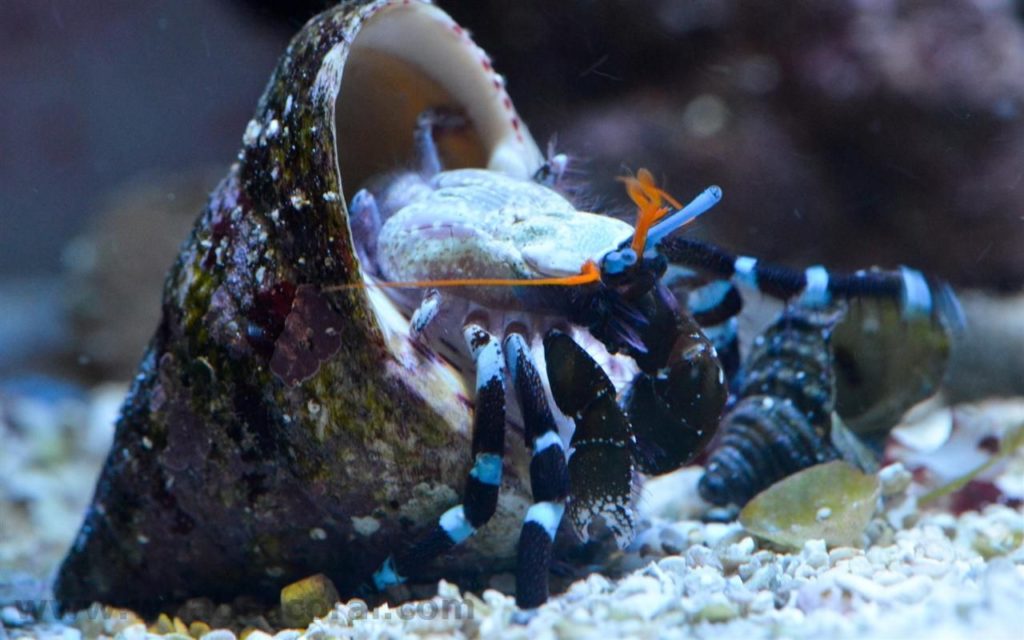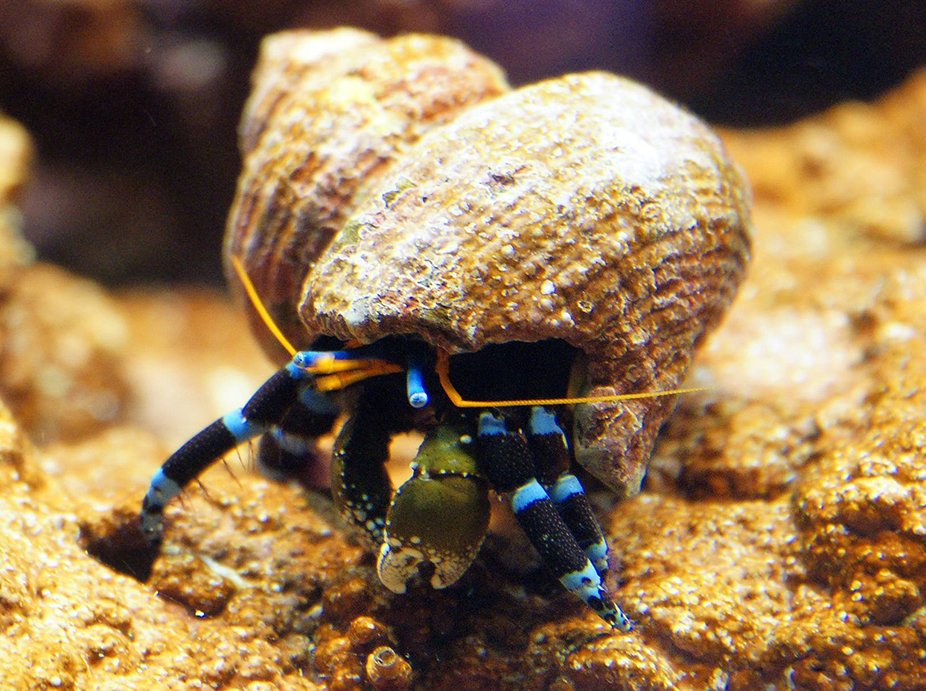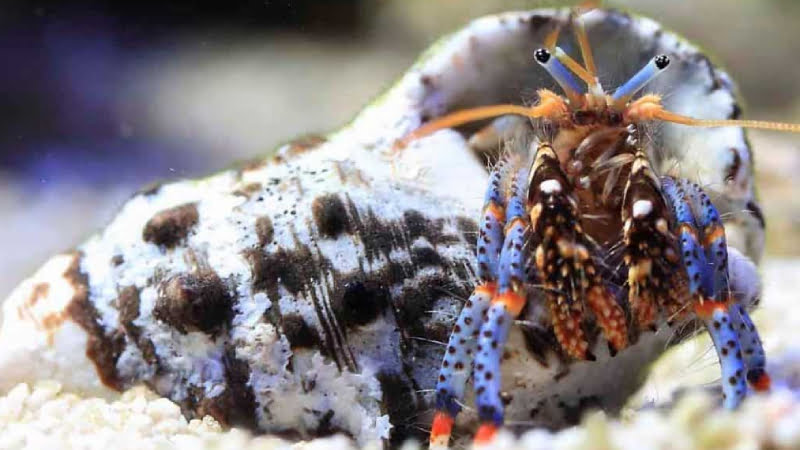The electric blue hermit crab is a fascinating creature. They are often kept as pets in aquariums, but they require special care and attention, difficult for many people to provide. It’s important to keep electric blue crabs healthy so that they live a long life – but how long do electric blue crabs usually live?
In this blog post, we’ll take an in-depth look at the electric blue hermit crab lifespan and what factors affect it!
See also:
- How Big Do Emerald Crabs Get? How To Take Care Of Them?
- Do Puffer Fish Eat Crabs? Top 5 Impressed Facts About Puffer Fish.
The Facts About Electric Blue Hermit Crab
Clibanarius tricolor is a hermit crab with blue legs and red bands and can reach up to 3/4″ (2 centimeters) in size. Especially among aquarium home trades, this species has become very popular. Intertidal zones are their habitat, where they consume detritus and algae. During the night, they are more active than during the day.
While they will climb over anything in the aquarium, they are reef safe and do not disturb corals. This may cause them to close temporarily. Crabs such as blue-legged hermit crabs are capable of living for up to 30 years in the wild. In an aquarium, however, they only last for an average of two to three years.
Electric blue hermit crab Diet & Nutrition
Most aquarium foods are scavengers for this fish. In addition to eating live plants and animals, it is a detritivore. Also, it consumes green hair algae, cyanobacteria, and seaweed. As a result of its feeding habits, it keeps aquarium tanks clean, which helps sustain the aquarium ecosystem and reduces the need for maintenance by the owner.
Determining the sex of electric blue hermit crab
As a general rule, males are more significant than females. Besides the size difference, there is no visible sexual dimorphism externally. Hermit crabs will usually come out of their shells for you unless they are incredibly adventurous.
Hermit crabs’ sex can be determined based on the presence or absence of external primary sexual characteristics. There are tiny openings called gonophores on the female hermit crab’s genitalia. A female’s gonophores can be found at the base of her third pair of pereopods, while males are located at the bottom of her fifth pair. Hermit crabs that have blue legs also have intersex individuals. The Clibanarius tricolor species, however, do not frequently exhibit these characteristics.
Breeding & spawning electric blue hermit crab
During their temporary outgrowth period, blue-legged hermit crabs mate while still partially encased. The Clibanarius tricolor reproduces through spawning, meaning the female lays her eggs in the water, and the male releases his sperm to fertilize the eggs. In aquariums, however, breeding these species is very problematic.

Electric blue hermit crab origin
These species are primarily found in shallow waters in the tropical western Atlantic Ocean, such as those in the Caribbean Sea, Florida, and the Gulf of Mexico.
Caution with electric blue hermit crab
The Blue-Legged Hermit Crab is susceptible to large swings in water parameters, as are many invertebrates. Furthermore, Copper medication should never come into contact with it in the water as it does not tolerate any metal traces.
Acclimating electric blue hermit crab
It is recommended that hobbyists acclimate their cleaner crews to unusable water conditions because invertebrates generally do not like significant changes in water parameters. Your cleaning crew should be positioned in a low-light area when you have a sump to allow them to adjust to the temperature. This should take about fifteen minutes. If you do this, they should change your water’s conditions over time slowly.
Electric Blue Hermit Crab Lifespan
Before learning about electric blue hermit crab lifespan, let’s know about other related issues, such as habits, to see how they are connected and affect their lifespan.
The Behavior Of The Electric Blue Hermit Crab
These experiments show that Blue Legged hermit crabs have a high degree of site fidelity in the wild and don’t move much daily. Their home often ranges not exceeding 2 meters in diameter.
The species of this genus live at night. A crab’s day is spent resting or moving slowly. The feeding process begins at dusk and continues throughout the night. Social and relatively peaceful, blue leg hermit crabs live together in large colonies. These animals usually congregate around fallen rock faces covered with detritus. They prefer to hang out with their group of hermit crabs with blue legs. As a result, they will feel more at ease and secure.

A second experiment involved marking two shells with red and blue ink and replacing them in their respective groups. The observations for the first few days showed relative group stability. Blue Leg Hermit Crabs returned to their groups in the majority (82%) of cases.
Comparatively speaking, the Cribanarius tricolor does not move very quickly or slowly. Individuals who attempt to crawl over an obstacle often fall backward despite being surprisingly agile for an organism with so much extra weight. The movement of the second leg helps them right themselves more quickly.
When meeting, Blue Leg Hermit Crabs typically do not show any change in their behavior. It is possible for them to crawl over one another or to pass each other without noticing. Hermit crabs frequently show no differences in behavior when one starts making aggressive movements unless they are attacked.
How Many Electric Blue Hermit Crab Lifespan?
A nighttime activity is more common than a daylight activity. While they will climb over anything in the aquarium, they are reef safe and do not disturb corals. This may cause them to close temporarily. Crabs such as blue-legged hermit crabs are capable of living for up to 30 years in the wild.
FAQs
How long can hermit crabs live in captivity?
If the wild hermit crab is fortunate enough to live his life in his natural habitat, he can live up to 30 years. A crab in captivity may have a much shorter life, not even reaching one year. However, with proper care, your crab can live up to 20 years.
Do electric blue hermit crabs molt?
Because it’s probably a molt, it does look like a real-life hermit, but it’s 90% of the time just its old “skin” like the one you see here.
Do hermit crabs like to be held?
Please don’t pick them up every day. First of all, hermit crabs do not particularly like being handled. They are not the kind of pet you take out to cuddle. Sorry if that’s what you were looking for.
Conclusion
The electric blue hermit crab is a popular pet because of its easy care requirements and colorful appearance. These crabs are native to the Caribbean but can now be found in saltwater aquariums across America. I hope to bring you practical knowledge with the information that the article has provided electric blue hermit crab lifespan. Wish you have a beautiful tank for yourself!!!

Annette M. Chaney is an experienced marine biologist with over 20 years of experience as an aquarist and fishkeeper. She started her first aquarium at a young age, filling it with frogs and goldfish obtained from the ten-cent pet store.
Annette grew up caring for and breeding African Cichlids, which led to a hobby in high school that doubled as a profitable means. Attending Reed College gave her time to solidify herself as an accomplished aquarium caretaker with an eye for sales. After that, from 2009 – 2013, she studied at Roger Williams University – one of the most prestigious universities for Aquaculture and Aquarium in USA. She is the founder of AquariumCircle since 2010.
